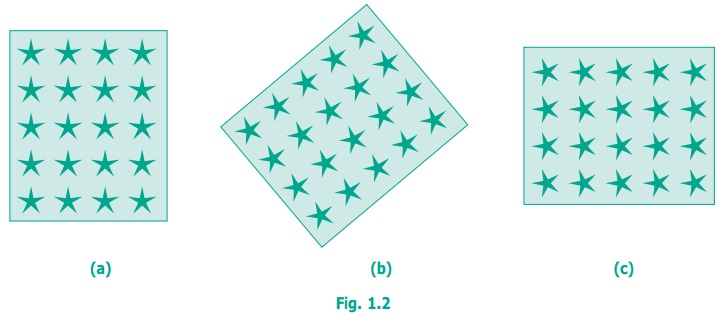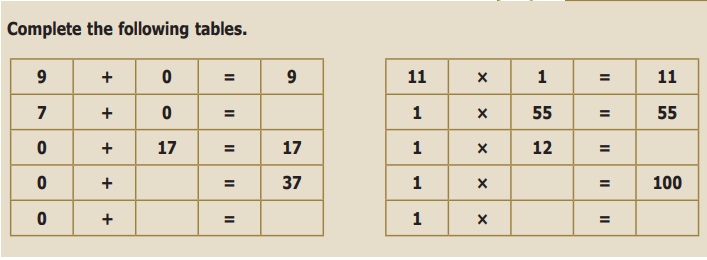Numbers | Term 1 Chapter 1 | 6th Maths - Properties of Whole Numbers | 6th Maths : Term 1 Unit 1 : Numbers
Chapter: 6th Maths : Term 1 Unit 1 : Numbers
Properties of Whole Numbers
Properties
of Whole Numbers
1. Commutativity of addition and multiplication
When two numbers are added (or multiplied), the
order of the numbers does not affect the sum (or the product). This is called commutativity of addition (or multiplication).
Observe the given facts:
43+57 = 57+43
12×15 = 15×12
35,784 + 48,12,69,841 = 48,12,69,841 + 35,784
39,458 × 84,321 = 84,321 × 39,458
Such facts are called as equations. In each of the
above equations, the answers on both the sides are same. Finding the answer for
the third and fourth equations takes more time. But, these equations are meant to
convey the properties of numbers. The third equation is correct by commutativity
of addition and the fourth equation is correct by commutativity of multiplication.
There is a nice pictorial way of understanding commutativity
of multiplication. If we have 5 rows of stars, each with 4 stars, we can draw the
total of 20 stars as a rectangle (5 × 4 = 20). See Fig.1.2 below. Now rotate the
rectangle, Fig.1.2 (a) to get the Fig.1.2(c) as given below. It is the same rectangle.
It has exactly the same total number of stars, 20. But now we have 4 rows of stars,
each with 5 stars! That is, 5 × 4 = 4 × 5.

Now, look at the following example.
7– 3 = 4 but 3 – 7 will
not give the same answer. Similarly, the answers of 12 ÷ 6 and 6 ÷ 12 are not equal.
That is, 7 – 3 ≠ 3 – 7 and 12 ÷ 6 ≠ 6 ÷ 12
Hence, subtraction and
division are NOT commutative.
Try these
● Use at
least three different pairs of numbers to verify that subtraction is not commutative.
Solution:
Three different pairs
(i) (8 — 3) — 2 ≠ 8 — (3 — 2)
5 − 2 ≠ 8 − 1
3 ≠ 7
(ii) (6 − 2) − 2 ≠ 6 − (2 − 2)
4 − 2 ≠ 6 − 0
2 ≠ 6
(iii) (10 − 5) − 2 ≠ 10 − ( 5 − 2)
5 − 2 ≠ 10 − 3
3 ≠ 7
• Thus we verify that subtraction is not commutative.
● Is 10 ÷ 5, the same as 5 ÷ 10? Justify
it by taking two more combinations of numbers.
Solution:
10 ÷ 5 = 2 and 5 ÷ 10 = 1/2
9 ÷ 3 = 3 and 3 ÷ 9 = 1/3
100 ÷ 10 = 10 and 10 ÷ 100 = 1/10
We justify the answer is reciprocal
2. Associativity of addition and multiplication
When several numbers are added, the order in which
the numbers are added does not matter. This is called associativity
of addition. Similarly, when several numbers are to be multiplied, the order
in which the numbers are multiplied does not matter. This is called associativity of multiplication.
It can be said that the following equations are
correct, without actually doing any addition or multiplication, but by using the
property of associativity. A few examples are given below:
(43 + 57) + 25 = 43 + (57 + 25)
12 × (15 × 7) = (12 × 15) × 7
35,784 + (48,12,69,841 + 3) = (35,784 + 48,12,69,841) + 3
(39,458 × 84,321) × 17 = 39,458 × (84,321 × 17)
It is to be noted that
here too, subtraction and division are NOT associative.
3. Distributivity of multiplication
over addition or subtraction
An interesting fact relating to addition and multiplication
comes from the following patterns:
(72 × 13) + (28 × 13) = (72 + 28) × 13
37 × 102 = (37 × 100) + (37 × 2)
37×98 = (37 × 100) – (37 × 2)
In the last two cases, we are actually noting down
the following equations:
37 × (100 + 2) = (37 × 100) + (37
× 2)
37 × (100 − 2) = (37 × 100) – (37
× 2)
It can be noted that the product of a number and
a sum of numbers can be written as the sum of two products. Similarly, the product
of a number and a number got by subtraction can be written as the difference of
two products. This property is called as property of distributivity of multiplication
over addition or subtraction. It is a very useful property to group numbers in a
convenient way. Now let us say 18 × 6 = (10 + 8) × 6
in an easy way as shown in Fig.1.3.

Thus, 18 × 6 = (10 +
8) × 6 is shown clearly in the above figure.
It is to be noted that addition
does not distribute over multiplication.
For example,
10 + (10 × 5) = 60 and (10 + 10) × (10 + 5) = 300
are not equal.
4. Identity for addition and multiplication
When zero is added to any number, we get the same
number. Similarly, when we multiply any number by 1, we get the same number. So,
zero is called the additive
identity and one is called the multiplicative identity for whole numbers.
Try these


Finally, these are some simple observations that
are important.
● When we add any two natural numbers, we get a natural
number. Similarly when we multiply any two natural numbers, we get a natural number.
● When we add any two whole numbers, we get a whole number. Similarly when
we multiply any two whole numbers, we get a whole number.
● When we add a natural number to a whole number, we get a natural number.
When we multiply a natural number by a whole number, we get a whole number.
Note
● Any number multiplied by zero gives
zero.
● Division by zero is not defined.
Try these
Complete the table.

All such properties together play a vital role in
the Number System. When we learn Algebra, we
can realise the usefulness of these properties of the Number System and we can find
ways of extending it too.
Related Topics